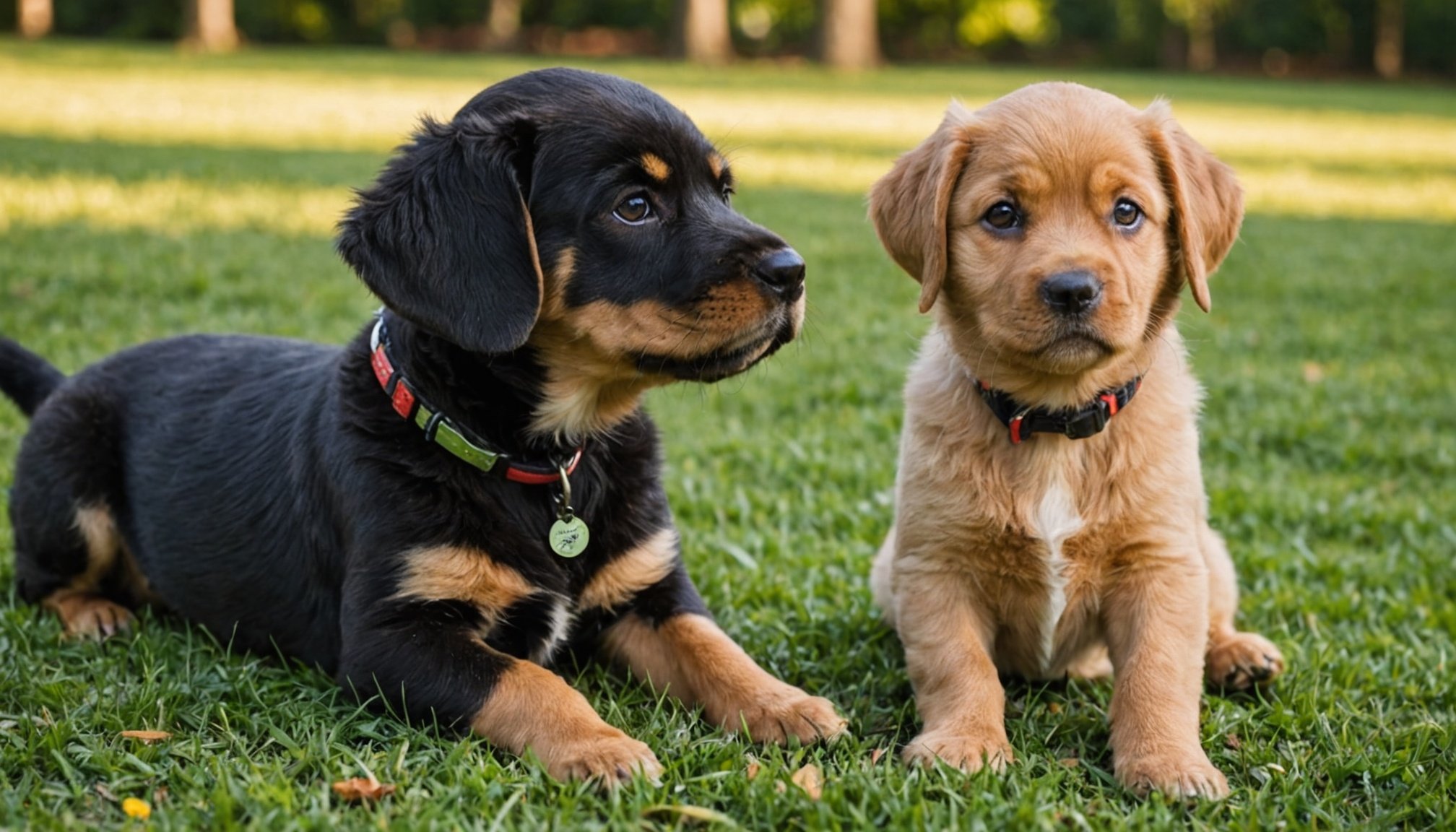Understanding the Importance of Socialization
Puppy socialization plays a pivotal role in every pup’s development. Early socialization impacts how a puppy perceives the world, fundamentally shaping their behaviour and well-being. During the first few weeks of life, introducing puppies to diverse environments, people, and other animals helps in developing a confident, sociable pet.
Engaging in varied benefits of pet interaction is advantageous. By exposing puppies early, they learn how to adapt, reducing the likelihood of behavioral problems such as fear or aggression later on. Experiences with different pets and settings encourage adaptability and boost confidence, making them more comfortable with novel situations.
In parallel : Crafting the Ultimate Ferret Playground: Safe and Stimulating Spaces for Your Furry Friends
Conversely, insufficient socialization can lead to various issues. Puppies might develop anxiety or aggression due to fear of unknown environments or animals. This can result in long-term challenges, affecting their quality of life and their owner’s experiences.
Thus, embracing early socialization is essential for nurturing well-adjusted dogs. By understanding the importance and acting promptly, one can ensure their furry friend grows into a well-behaved companion. The benefits of early integration into diverse environments cannot be overstated, as it lays the groundwork for a happy, sociable pet.
This might interest you : Ultimate guide to cat training: proven strategies to inspire your feline friend to love the scratching post
Preparing for the Socialization Process
Embarking on preparation for puppy socialization is crucial for a positive outcome. Start with gathering essential supplies like leashes, treats, and toys. These tools facilitate structured interactions and enable you to reinforce positive behaviours effectively.
Create a safe environment for initial meetings. This involves selecting an area free from potential hazards and distractions. A controlled setting ensures that puppies can explore safely while feeling secure. Moreover, establishing a consistent, calm atmosphere aids their confidence and curiosity during interactions.
Identifying ideal opportunities for socialization essentials is equally significant. Engage your puppy with different settings and other pets progressively. Begin with familiar pets to ease the introduction, gradually incorporating new animals and environments as your puppy becomes more comfortable. This progression fosters adaptability and diminishes anxiety associated with new experiences.
In summary, the key is preparation and structure. By equipping yourself with the right tools and creating a supportive environment, you set a foundation for successful puppy socialization. The goal is not only to introduce your puppy to varied scenarios but to ensure these experiences are constructive and enjoyable, paving the way for a harmonious development.
Step-by-Step Techniques for Introducing Your Puppy to Other Pets
Introducing your puppy to other pets requires careful planning and execution to foster positive interactions. The introduction techniques should be implemented thoughtfully to ensure a seamless blending.
Controlled Introductions
In the beginning, gradual exposure is key. Initiate contact in a neutral space, allowing both animals to become familiar without feeling territorial. Always maintain supervised introductions, observing the dynamic closely and being ready to intervene if tension arises. Recognise and understand body language, as it can indicate comfort or over-stimulation.
Positive Reinforcement Strategies
Encouraging positive associations through treats and praise reinforces good behaviour. This strategy aids in creating a link between new encounters and rewarding experiences. Consistency is crucial; ensure reinforcement occurs at appropriate times to solidify learning. Negative behaviours should be managed swiftly with calm redirection, highlighting desired actions.
Gradual Exposure Approach
Introduce other types of pets over time, beginning with those similar in temperament. Set realistic goals, focusing on small successes to ease complex introductions. Assess each interaction, adjusting techniques based on your puppy’s progress. Recognising the puppy’s pace ensures they feel secure, building towards confident and social behaviour patterns.
Behavioral Insights during Socialization
Understanding pet behaviour during socialization is essential for anticipating and addressing potential challenges. Recognizing and interpreting puppy body language plays a crucial role. By observing subtle cues such as tail position, ear posture, and vocalizations, owners can gauge their puppy’s comfort levels and readiness for interaction.
Identifying signs of fear or aggression early is paramount. Puppies may display anxiety through behaviours like cowering, excessive panting, or avoidance. Aggressive responses can include growling, snapping, or lunging. It’s vital to intervene constructively, redirecting these behaviours calmly to maintain a positive experience.
Strategies to mitigate stress and anxiety are beneficial. Introducing a comforting object, like a favourite toy, can provide reassurance. Gradually increasing exposure time and praising relaxed behaviour helps build resilience. In some cases, employing calming aids such as pheromone diffusers can also be effective.
During interactions, ensuring a balanced environment where neither pet feels overwhelmed is key. Paying close attention to the body’s signals allows for timely adjustments, promoting smoother socialization experiences. By being observant and proactive, owners can foster more harmonious connections between their new puppy and other pets, ultimately enhancing their pet’s adaptability and sociability.
Common Challenges and Solutions
Socialization challenges can appear daunting when introducing a new puppy to the world. Socialization challenges often include fear and aggression, especially when puppies encounter unfamiliar settings or animals. Identifying these obstacles is the first step in overcoming them.
Proven solutions exist to tackle these common issues. Overcoming obstacles involves positive reinforcement techniques, as they are crucial in encouraging desirable behaviours. Celebrate small victories by rewarding calmness and curiosity. Redirection strategies, like shifting focus with toys, can also help in stressful situations.
Sometimes, challenges persist despite our best efforts. In such cases, seeking expert solutions is wise. Consulting a professional trainer or a behaviourist can provide invaluable insights and tailored approaches to your puppy’s needs. These experts assess individual behaviours and offer guidance on effective methods to ease anxiety and foster social adaptability.
Consistent and informed interventions promote a smoother transition for both the puppy and their owner. Understanding and addressing the nuances of socialization challenges ensures not only the well-being of your puppy but also the development of a trusting and fulfilling relationship. By recognising when expert help is needed, you pave the way for a successful socialization journey.
Real-Life Case Studies and Examples
Learning from others’ experiences can be invaluable when tackling puppy socialization. Successful socialization success stories serve as a guiding light for new pet owners.
Case Study: Bella, the Timid Puppy
Bella, initially a shy and fearful puppy, transformed through a structured socialization process. The owner initially faced challenges due to Bella’s reticence around other animals. Gradually, through effective techniques such as the gradual exposure approach, Bella warmed up to new environments and pets. Consistent use of positive reinforcement was vital; rewarding calm behaviours played a key role. Over time, Bella’s confidence blossomed.
Insights and Techniques
From the trenches of real experiences, timing was critical. Determining the puppy’s pace ensured Bella wasn’t overwhelmed. Encounters started short and positive, incrementally increasing in duration and complexity, aligning with her comfort levels.
Training anecdotes underline the power of patience and strategic interventions. Relationship-building wasn’t rushed, emphasising quality interactions over quantity. Through adaptable methods and maintained consistency, the owner successfully overcame initial hurdles, turning Bella into a well-adjusted pet, capable of engaging positively with its environment. Bella’s journey reflects the potential within tailored socialization strategies to reshape initial hesitations into enthusiastic social adaptability.

